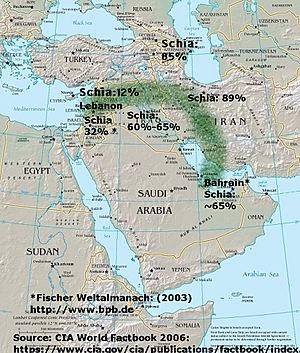Shia crescent facts for kids
The Shia Crescent is a term used to describe a region in the Middle East. In this area, many people follow the Shia branch of Islam, or there are large groups of Shia Muslims living there. It's called a "crescent" because of its shape on a map.
Recently, this term has also been used to talk about areas where Iran has a lot of influence or control. Iran is a country with a large Shia population. This idea also shows that Shia Muslims are becoming more important in the Middle East.
Countries and areas often included in the Shia Crescent are Lebanon, Syria, Bahrain, Iraq, Iran, Azerbaijan, Yemen, and western Afghanistan. Besides the main group of Shia Muslims (called Twelver Shia), the term can also include other Shia groups like Ismailis, Zaydis, Syrian Alawites, and Bektashis in Turkey.
Contents
What is the Shia Crescent?
The term "Shia Crescent" was first used in 2004 by King Abdullah II of Jordan. This was when Iran was thought to be getting involved in Iraq's politics. At that time, Iraq was preparing for an important election. Some people worried that a Shia-led government in Iraq might become too close to Iran.
The idea was that countries with many Shia Muslims, like Iran, Iraq, Alawite-led Syria, and the powerful Shia group Hezbollah in Lebanon, might work together. Some thought these groups could even act on behalf of Iran in the region.
Why is it important?
Over time, the term "Shia Crescent" started to include other Shia areas in the Middle East. The countries where Shia Muslims are the main group are Iran and Iraq. Azerbaijan also has a large Shia majority, but it is a country that separates religion and government. Because of this, Azerbaijan is often not included in the "crescent" idea.
Shia Muslims are also the majority in Bahrain, but its government is mostly Sunni. There are also many Shia Muslims in Lebanon, Kuwait, Yemen, Saudi Arabia, Turkey, Afghanistan, Pakistan, India, and the UAE. However, these places are usually not called part of the crescent, except for Lebanon. In Lebanon, a group called Hezbollah has become very involved in the Syrian civil war.
Different Views on the Crescent
Some leaders have different opinions about the "Shia Crescent" idea. For example, Ayatollah Khamenei, Iran's top leader, said in 2005 that the "Shia Crescent" idea was meant to divide Muslims.
Later, in 2015, Iranian President Hassan Rouhani said that there is "neither a Shiite nor a Sunni crescent." He believed that Muslims should unite and work together. He said, "We have an Islamic moon."
Noam Chomsky, a famous American professor, has written about the "Shia Crescent" too. He suggests that most of the Middle East's oil is found in this area. He believes that Iran's growing influence in the Shia Crescent could challenge how the United States controls oil resources.
In 2016, a close advisor to Saudi Crown Prince Mohammad bin Salman said that the Arab world was facing a "Shia full moon." This was because Iranian-backed Shia groups were becoming more active in countries like Iraq, Syria, and Yemen.
Changes in Population
A professor named Hussain Ibrahim Qutrib wrote about how the population changed in parts of Syria. He looked at areas that Syrian President Bashar al-Assad called "Useful Syria." These areas included cities like Damascus and Homs.
In 2011, about 9.8 million people lived in "Useful Syria." Most of them (69%) were Sunni Muslims. About 21% were Alawite, a group related to Shia Islam. Only 1% were Shia.
By 2016, the population in "Useful Syria" dropped to 7.6 million. But the types of people living there changed a lot. The percentage of Sunni Muslims went down to 52%. The percentage of Alawites went up to 24%. Most notably, the percentage of Shia Muslims grew a lot, to 13%.
These changes were very clear in places like Rif Dimashq and Homs. In Rif Dimashq, the Sunni population went from 87% in 2011 to 54% in 2016. In Homs, it went from 64% to 21%. This big change in population, especially the increase in Shia Muslims, has been called "Shiization."
See also
 In Spanish: Media luna chiita para niños
In Spanish: Media luna chiita para niños
- Shia topics
- Iran–Saudi Arabia proxy conflict
- Axis of Resistance
- Shia–Sunni relations
- Shia Islam: Demographics
- Geography topics


